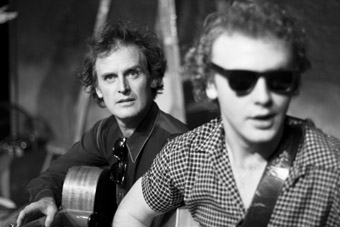still not there: dylan on film & stage
matthew clayfield: the chronic ills of robert zimmerman

Andrew Henry (Johnny Cash), Matt Ralph (Bob Dylan), Chronic Ills of Robert Zimmerman, Tamarama Rock Surfers
photo Declan Kuch
Andrew Henry (Johnny Cash), Matt Ralph (Bob Dylan), Chronic Ills of Robert Zimmerman, Tamarama Rock Surfers
FOR ANYONE WITH EVEN A PASSING ACQUAINTANCE WITH TODD HAYNES’ I’M NOT THERE (2007), IT WAS IMPOSSIBLE TO SIT THROUGH BENITO DI FONZO’S EPICALLY-TITLED PLAY THE CHRONIC ILLS OF ROBERT ZIMMERMAN: AKA BOB DYLAN (A LIE)—A THEATRICAL TALKING BLUES AND GLISSENDORF, WITHOUT BEING REMINDED OF CATE BLANCHETT’S JUDE QUINN: “I’M JUST A STORYTELLER, MAN. IT’S ALL I AM.”
For one thing, the resemblance of The Chronic Ills’ Matt Ralph to Blanchett’s Quinn is uncanny, as is their resemblance to Bob Dylan, the man on whom their characters are based. For another, the segment of Haynes’ film that Di Fonzo’s play most resembles is the one in which Quinn appears. (Jude is one of six Dylan doppelgängers in the picture, each of whom occupies a stand-alone storyline rendered in a distinct cinematic style.) Both the play and the Quinn segment share a classic pop art sensibility, all appropriation, allusion and madcap namedropping (The Beatles and Allen Ginsberg show up in the film; Joan Baez, John Lennon, Yoko Ono and more in the play). While Haynes’ reference points are predominantly cinematic—Fellini’s 8 ½ and Pennebaker’s Don’t Look Back are the most obvious in the Quinn segment, though Richard Lester’s Hard Day’s Night gets a look-in, too, and Jean-Luc Godard’s Masculin Féminin is referenced throughout all six of the characters’ segments—Di Fonzo turns to Dylan’s music. Mimicking the formal operations of the songs, if not necessarily echoing their content, the play careens along as though it were a lost verse of Subterranean Homesick Blues, relying less on narrative cohesion or biographical accuracy than on free association and impressionistic causal logic.
For some people’s money, this is the production’s greatest shortcoming (as indeed, for more of their money, is true of the film). On the night I saw The Chronic Ills, one person even remarked to me that it felt as though Di Fonzo had written the play in front of the Wikipedia entry on Dylan, resorting to superficial pop culture references and betraying an unfamiliarity with the work. This criticism misses the point, and twice. In fact, The Chronic Ills’ impressionistic streak is evidence of an intense familiarity with Dylan’s work and its internal operations: episodic, fast-paced and surreal, the result is a text constructed entirely out of what Ginsberg, describing the songwriter’s lyrics, once called “chains of flashing images.”
The more serious point missed by this criticism is the fact that the play isn’t really about Dylan at all and therefore needn’t hew too closely to the recorded facts of the troubadour’s life. Rather, the real subjects of the play are storytelling, mythmaking and the formation of identity.
Dylan is the perfect subject for such a project for the simple reason that he has been an active participant in his own mythologising for so long, albeit in a paradoxical, often contradictory manner. He has been lying to and glissendorfing journalists—using language to intentionally mess with them—since his emergence in the sixties (“Mr Quinn, Mr Quinn! Do you have a word for your fans?” “Astronaut.”) and has experimented with the conventions of self-representation and self-mythologising in films such as 1978’s Renaldo and Clara, which he directed, and 2003’s Masked and Anonymous, which he wrote. At the same time, he has bristled at any attempts by others to mythologise him without his consent. His refusal to play any of the roles the culture has prescribed for him, paired with the near-constant reinventions that have allowed him to avoid such prescriptions, gives him a mercurial quality that seems to make mythologisation impossible even as it invites further attempts. I’m Not There is particularly interested in the ramifications of this latter contradiction, and indeed is a product of it. Inspired, according to the opening credits, by Dylan’s music and “many lives,” it offers its complex, fragmented narrative as a metaphor for the various selves we carry inside of us and the unknowability of any whole of which they may ostensibly be a part. (Todd Solondz’s Palindromes did something similar three years earlier.)
The Chronic Ills comes at things from a different angle, suggesting that even in the face of this essential unknowability we might still be able to glissendorf some idea of ourselves into being. Where I’m Not There is about self-effacement—or at least attempts to navigate the terrain of the self-effaced—The Chronic Ills is about storytelling as an act of self-creation. Robert Zimmerman talked Bob Dylan into existence, and that lie, as the titular parenthetical calls him, has been talking himself further into it ever since. What Di Fonzo captures so well with his wordplay monologues and his indifference to the historical record is the idea that a life is as much a work of art as any song or film or play. This is true of any life, of course, but of the artist in question it’s particularly so. Dylan’s life has been a performance fashioned almost entirely out of poetry and lies, which is really just another way of saying out of stories.
Tamarama Rock Surfers, The Chronic Ills of Robert Zimmerman: AKA Bob Dylan (A Lie), A Theatrical Talking Blues and Glissendorf , writer Benito Di Fonzo, director Lucinda Gleeson, performers Andrew Henry, Lenore Munro, Matt Ralph and Simon Rippingale, designer Eliza McLean, lighting design Richard Whitehouse, producers Jennifer Hamilton, Sophie Alize Finnane; Old Fitzroy, Sydney, April 6-24
RealTime issue #97 June-July 2010 pg. 36






